Carryover Stocks
Falling stocks since the mid-1970s
|
 |
World cereal stocks by the close of the seasons ending in 2003 are forecast to reach 470 million tonnes, up slightly from the previous report, but some 108 million tonnes, or 19 percent, smaller than in 2002 and the lowest level in more than two decades. The decline is mostly due to a sharp drop in world cereal production and the continuing drawdown of stocks in China and India.
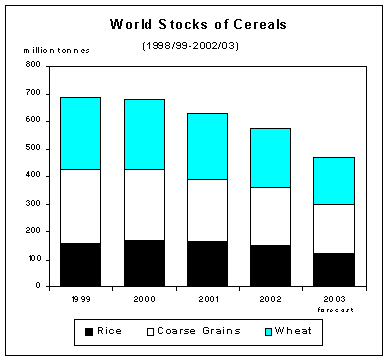 Global wheat inventories, by the close of the seasons ending in 2003, are forecast to reach 170 million tonnes, 48 million tonnes, or 22 percent, below their already reduced opening levels. Aggregate wheat stocks in major exporting countries are forecast at 34 million tonnes, down 13 million tonnes from the previous year and the smallest volume since 1996, driven by sharp drops in production in the United States, Canada and Australia. Among the major exporters, only EU is forecast to end the season with larger stocks. A sharp recovery in production and large imports are among the main reasons for the increase in EU wheat stocks. The decline in major exporting countries’ wheat stocks would imply a significant drop in the ratio of their wheat stocks to their total disappearance (the sum of their domestic consumption and exports) to 16 percent, compared to 21 percent in the previous season.
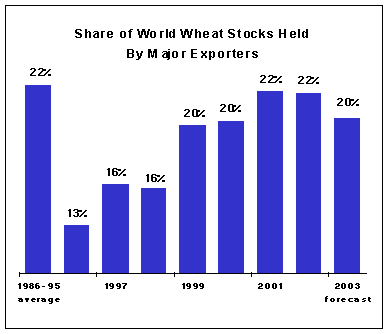 | | Crop year ending in: | | | 2001 | 2002 estimate | 2003 forecast | | | (million tonnes) | | Wheat | 240.3 | 218.1 | 170.4 | | Coarse grains | 225.7 | 211.0 | 176.3 | | of which: | | | | | Maize | 181.2 | 159.6 | 132.3 | | Barley | 25.7 | 28.8 | 23.4 | | Sorghum | 5.2 | 6.4 | 5.0 | | Others | 13.6 | 16.2 | 15.6 | | Rice (milled) | 162.8 | 148.4 | 123.0 | |
TOTAL |
628.8 |
577.5 |
469.7 |
Source: FAO
Wheat stocks are also forecast to contract by 24 million tonnes in China, and 5 million tonnes in India. Both countries are among the world’s leading wheat producers. The drop in production in China and large wheat exports by India would necessitate sharp drawdowns from their stocks this season, although they would still remain large. Despite higher production in 2002, wheat inventories in Pakistan are also forecast to contract, by some 3.5 million tonnes due to large exports and strong domestic demand. Lower stocks are also anticipated in Algeria, Egypt, Ethiopia, and Tunisia, mostly due to lower production. By contrast, the overall stock level in the CIS countries is expected to exceed the previous year’s level in view of larger production in many countries. Wheat stocks are expected to decline only in the Russian Federation, mainly because of a surge in exports.
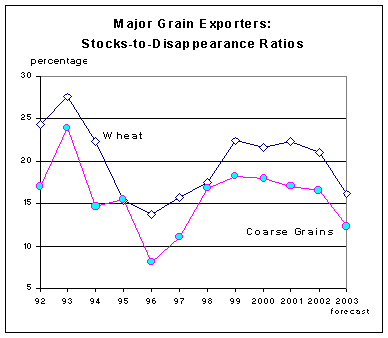 World coarse grain inventories for crop years ending in 2003 are forecast at 176 million tonnes, down 35 million tonnes, or 16 percent, from the previous year. The contraction is mostly driven by the situation in the United States and China. In the United States, a sharp fall in coarse grains production in 2002 is expected to result in a drop of over 16 million tonnes in its stocks to 28.5 million tonnes, the smallest since 1997. The drought reduced outputs in Australia and Canada would also result in a sizeable drop in their ending stocks, while total inventories in the EU are forecast to decline slightly because of a small decrease in its production in 2002 and an expected increase in exports. Consequently, for major exporters as a whole, the ratio of their total coarse grain stocks to their total disappearance is forecast to plunge, to 12.5 percent, the lowest level since 1996 and well below the estimated 16.5 percent in the previous season.
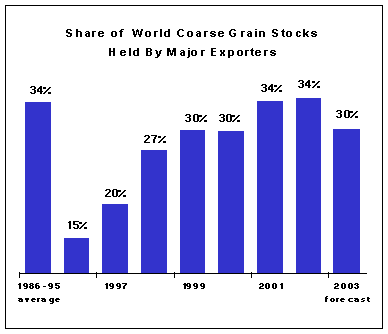 In China, while production rose in 2002, the deliberate policy to reduce stocks through exports continues and inventories are expected to contract by around 9 million tonnes. Sharp declines in maize production in Brazil and Mexico are behind the forecast decrease in coarse grains stocks in those countries. In addition, larger exports, mostly of barley, from the Russian Federation and Ukraine would also result in slightly lower ending coarse grain stocks in those countries. In Africa, a strong rebound in maize production in the Republic of South Africa is expected to result in improved stock levels in that country, whereas, the overall declines in sorghum and maize output in Africa would lead to lower inventories in many counties including Egypt, Ethiopia, Kenya, Sudan and Uganda.
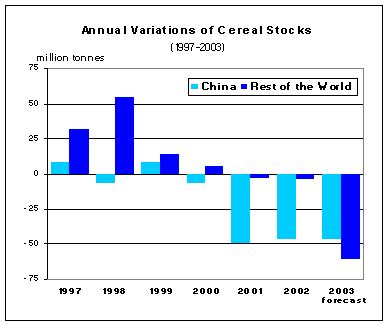 The forecast of world rice stocks at the end of the marketing seasons in 2003 has been lowered by about 600 000 tonnes and now stands at 123 million tonnes, 25 million tonnes below their opening level and one of the lowest levels on record. Based on the new estimate, the global rice stock-to-utilization ratio fell to 30 percent, compared with 36 percent at the end of last season. The downward revision in stocks was brought about by the new, lower estimates for production in China (mainland) and India, which together account for the bulk of world inventories. Estimates of closing inventories were also lowered from the last report for Indonesia, Japan, and the United States.
Compared with the previous year, the latest forecasts point to some increase in rice inventories in Bangladesh and Viet Nam, sustained by the excellent harvests they gathered in 2002, and in Indonesia, helped by a surge in imports. By contrast, rice closing stocks in Peru, Nigeria, Cote d’Ivoire, Senegal and the United States are expected to fall. However, most of the year-to-year global contraction would be mainly on account of Mainland China, where end-of-season stocks are estimated to have fallen by about 15 million tonnes to an FAO estimate of 78 million tonnes and in India, with a drop of 10 million tonnes from opening levels.
|





